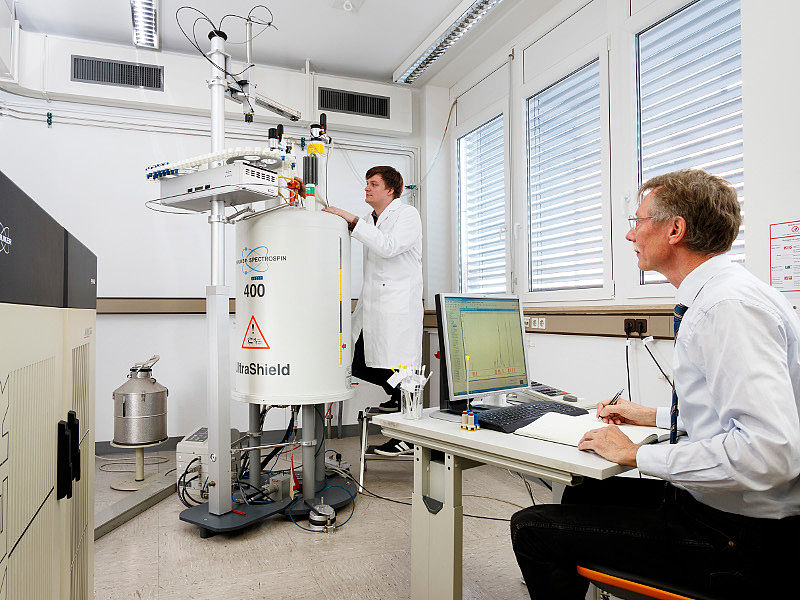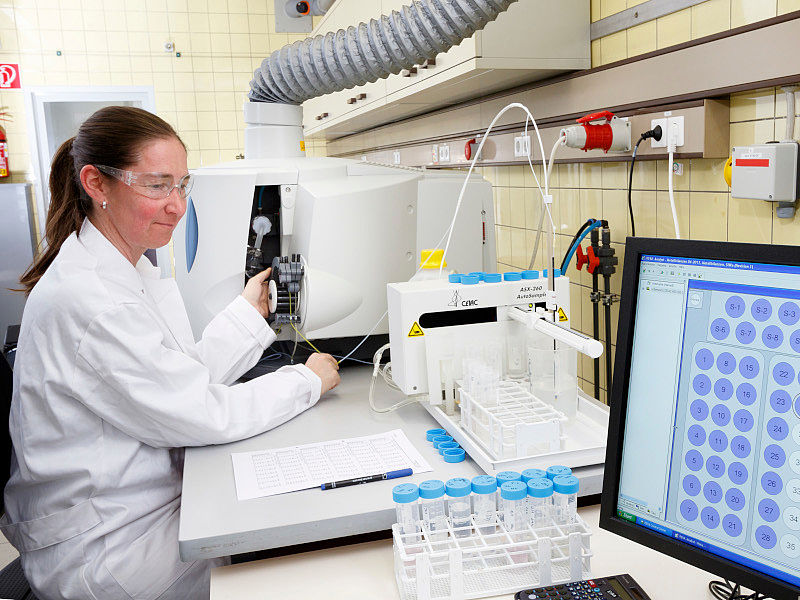Methods
Spectroscopy
The following list briefly explains the principle of some of our spectroscopy methods.
In addition, typical areas of application are presented as examples:
NMR (Nuclear Magnetic Resonance)
- High-resolution NMR spectroscopy is a method for the detailed structural elucidation of organic substances. For this purpose, the samples are brought into a strong magnetic field and irradiated with radio frequency pulses. The change in the magnetization of the elements (e.g. hydrogen and carbon) depending on their chemical environment is observed. The spectra obtained provide information about functional groups, compound classes, ratios of individual molecular parts to each other, structural isomerism and even the complete structure of compounds.
- Fields of application: NMR spectroscopy is applicable to all kinds of organic compounds including polymers. Mixtures can be quantified and impurities detected.
Molecular spectroscopy (IR/Raman/UV-Vis)
- Molecular spectroscopy involves the absorption or scattering of incident light. This is characteristic for certain molecular fragments. The recorded spectra show specific bands for certain molecule components, which makes it possible to identify organic materials in particular.
- Fields of application: Analysis of organic components, polymer characterization, damage analysis, stains and impurities, analysis of competitive products, ...
X-ray fluorescence analysis (XRF)
- The X-ray fluorescence spectrometer (XRF) provides the elemental composition of a sample and allows the detection of many elements in trace concentrations. The method is suitable for both solid and liquid samples.
- Fields of application: Trace analysis, checking materials for RoHS compliance (Restriction on Hazardous Substances), ...
Atomic emission spectroscopy ICP-OES
- ICP-OES allows the determination of elements in aqueous solutions by optical emission spectroscopy using inductively coupled plasma (argon). Due to the high plasma temperature (10,000 K), the compounds to be analyzed in the sample aerosols sucked in are atomised and additionally ionised. This raises the valence electrons to a higher energy level. When they return to their ground state, the previously absorbed energy is emitted as specific light energy. The ion lines are evaluated because they are quite insensitive to excitation disturbances. Advantages are better precision/reproducibility and detection limits. Simultaneous multi-element analysis of up to 70 elements is state of the art today.
- Fields of application: Metal and environmental analysis
Electron microscopy (SEM-EDX)
- The scanning electron microscope (SEM) is a device for imaging surface structures. Images of high resolution and depth of field are obtained. In addition, the distribution of different materials can be visualised. With the help of energy dispersive X-ray spectroscopy (EDX), the local elemental composition of the different sample areas can also be analysed.
- Fields of application: Structure and composition of components, damage analysis, stains and impurities, analysis of competitive products, ...
Surface Analysis (ESCA)
- Electron Spectroscopy for Chemical Analysis (also XPS) analyses (semi-quantitatively) the elemental composition of the uppermost nanometres (10-15 atomic layers) of solids. The method also provides information about the bonding states of the elements. The ablation of layers by sputtering allows the measurement of the depth distribution of elements (depth profile).
- Fields of application: Adhesion, wetting problems, paint stripping, surface and interface characterization, corrosion protection, reactivity of catalysts, ...
Other chemical and physical analytical methods:






